Dr. Tobias Capwell BA MA MA PhD FSA, known to his friends and fellow jousters simply as Toby, was the Overall Champion of this year's Tournament of the Phoenix.
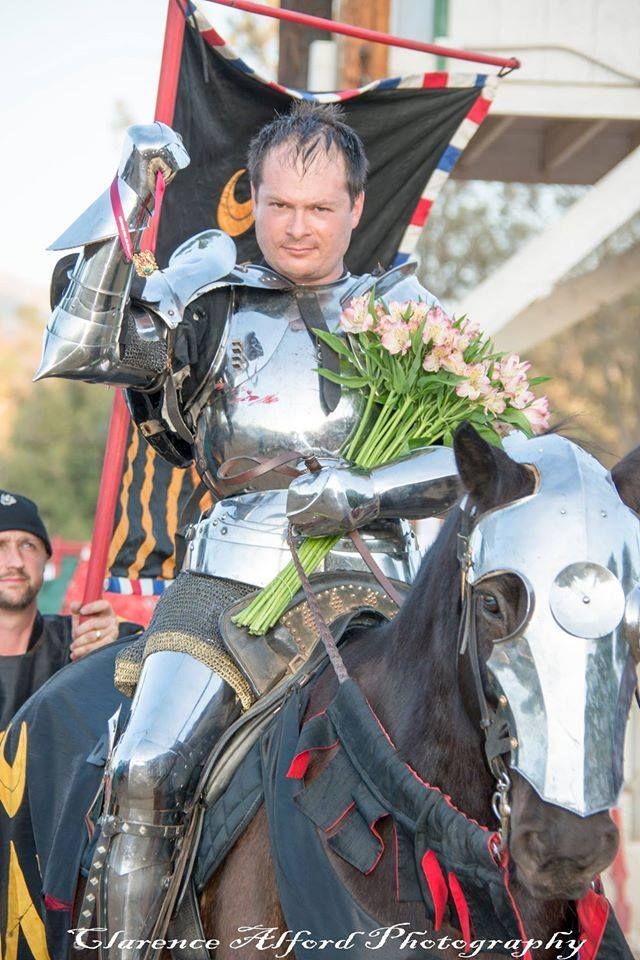
Toby Capwell, Tournament Champion, on the Azteca horse, Lucas, who carried Toby throughout the tournament, Tournament of the Phoenix 2014 (photo by Clarence Alford Photography)
This year's tournament was held the weekend of October 17 - 19, in Poway, California, USA, and involved not only a jousting competition, but also mounted melee and poleaxe competitions, as well as an award for the most chivalrous. There were a total of six jousters from five different countries who competed:
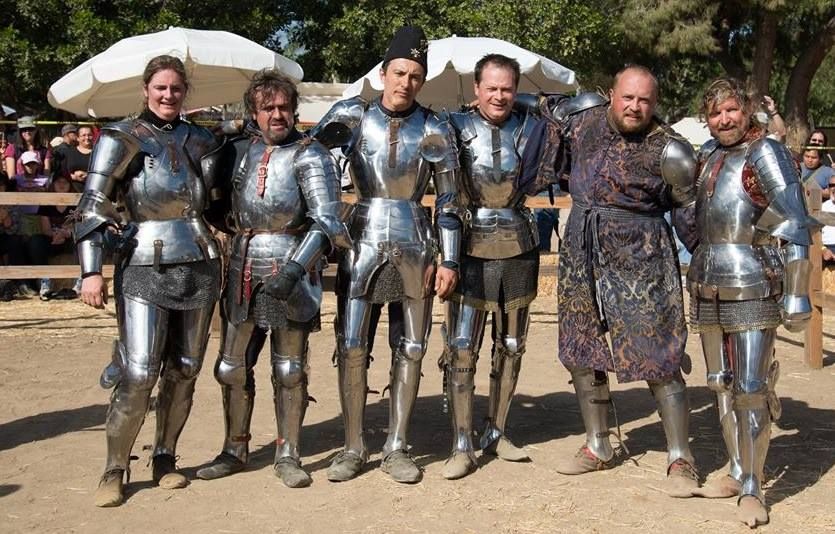
Left to right: Alix van Zijl, Luc Petillot, Darth Rimmer, Toby Capwell, Dmitry Savchenko
and Jeffrey Hedgecock (photo from Tournament of the Phoenix)
There was also a separate competition in mounted skill at arms which was won by Chris Godby.

Chris Godby, riding the Azteca horse Lucas, winner of the MSA competition,
Tournament of the Phoenix 2014 (photo by J. Camacho Photography)
This year's tournament champion, Toby Capwell, is not your average jouster. He is Curator of Arms and Armour at the Wallace Collection in London and is an internationally-acknowledged expert on medieval and Renaissance weapons. He has written widely on this fascinating subject. His books include: The Real Fighting Stuff: Arms and Armour at Glasgow Museums (Glasgow: Glasgow Museums, 2006); Masterpieces of European Arms and Armour in the Wallace Collection (London: Paul Holberton, 2011), winner of Apollo Magazine’s Book of the Year (2012); and The Noble Art of the Sword: Fashion and Fencing in Renaissance Europe 1520-1630 (London: Paul Holberton, 2012). The first book covering his fifteen years of research on armour in England during the fifteenth century will be published in 2015.
Toby also appears regularly on television, most recently as presenter and armour advisor on Richard III: The New Evidence (Channel 4; 2014), released in the USA as Secrets of the Dead: Resurrecting Richard III. He was also the writer and presenter of Metalworks: The Knight’s Tale (BBC4; 2012).
The world’s only jousting curator, Toby has been competing in tournaments all over the world for twenty years. Building and fighting in armour have fundamentally informed his scholarly approach to an intensely physical subject, allowing him to experience it in ways that would be impossible otherwise.
Toby approaches his subject in a passionate and unique way, offering personal and original insights into weapons, armour, horses, chivalric combat, and their deeper significance for the people who lived in the Middle Ages.
Toby Capwell explains his passion for jousting in a video created for the
Grand Tournament of Schaffhausen (video by Ritterturnier Schaffhausen)
Toby graciously agreed to answer some questions about winning the Tournament of the Phoenix and his other jousting experiences.
Congratulations on winning the Tournament of the Phoenix 2014!
Thanks!
How did you become involved with the Tournament of the Phoenix, and how long have you been competing in it?
I’ve known the event producers for a long time – Jeff and Gwen first started coming to the tournaments at the Royal Armouries in Leeds about ten years ago. Jeff and I formed a team with two other friends a bit later on. It all kind of went from there. I first fought at the Phoenix in 2008, and then have gone every other year since, again in 2010, 2012, and 2014.
Please describe one of your favorite moments during the tournament.
It’s funny, this time around it was small, perhaps slightly inconsequential things that made an impression on me. There was a moment during a pass run by Luc Petillot against someone else – can’t remember who – when Luc’s lance was knocked out of his hand by the force of his strike. The lance somehow bounced across his body and started to fall down between his horse’s near side and the tilt. Automatically, without looking or seeing, Luc reached down with his right hand across his body, still at a fast gallop, and retrieved it.
I was right at the end of the tilt and saw the whole thing perfectly. I was really impressed, because it showed not only skill, but also concern for the safety of the people around him. The historical jousting treatises say that the lance (or whatever is left of it) should never be thrown down after an encounter. The jouster should always hold on to it until it can be safely taken from him. Luc just showed in that moment that he was a real jouster with good awareness and the right attitude.
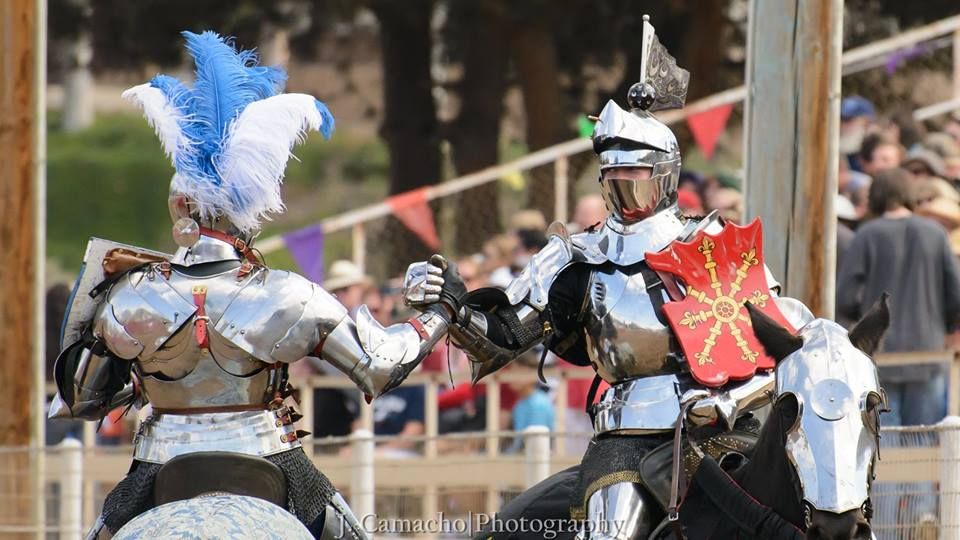
Luc Petillot(left) shakes hands with Toby Capwell(right), Tournament of the Phoenix 2014
(photo by J. Camacho Photography)
What is your favorite memory from any of your previous jousting experiences?
No question about it, when my 3-year-old son showed up unexpectedly in Switzerland this year, to see me joust in Schaffhausen. Seeing him peering over the grandstand railing was incredibly moving. He looked at me across the field, and I looked at him, I raised my hand, and he lit up and waved back. Magical.
Of course his favourite jouster now is Alix [van Zijl], not me. Understandable, I suppose.
How did you become involved with jousting?
Matthew Mansour gave me a job jousting for him back in 1993… I jousted in the USA for a couple years, then ended up in the UK, jousting at the Royal Armouries from 1996 onwards.
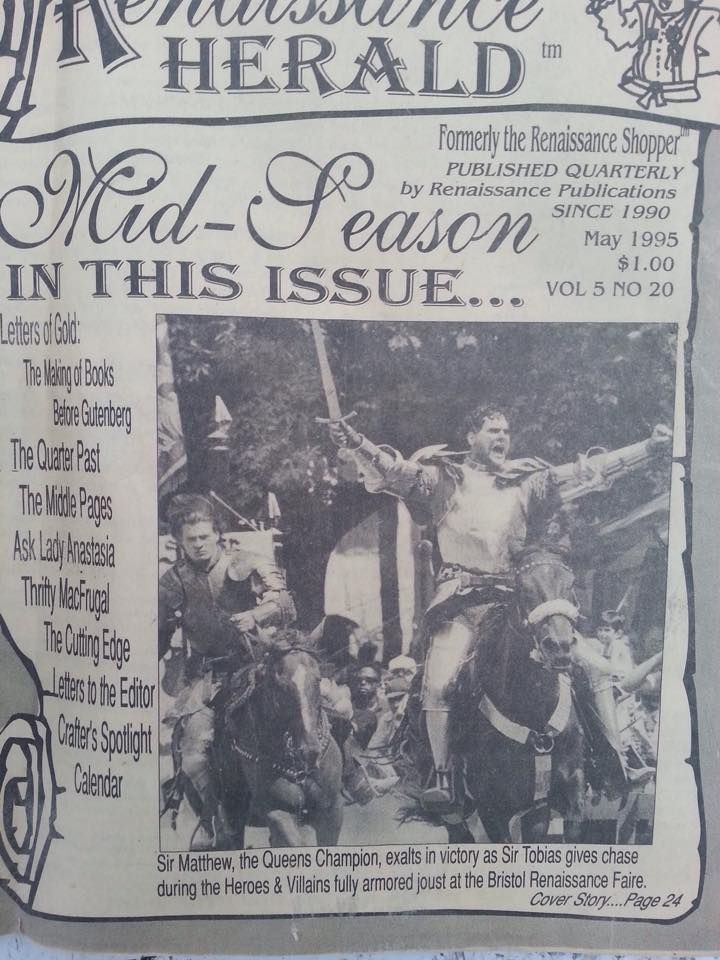
Toby Capwell(left) is featured with Matthew Mansour(right) on the cover of the
May 1995 Renaissance Herald (photo provided by The Jousters)
What aspect of learning to joust did you find most difficult?
Riding. It’s all about the riding. The rest is easy.
What accomplishment within the field of jousting are you most proud of?
Staying on. Most of the time.
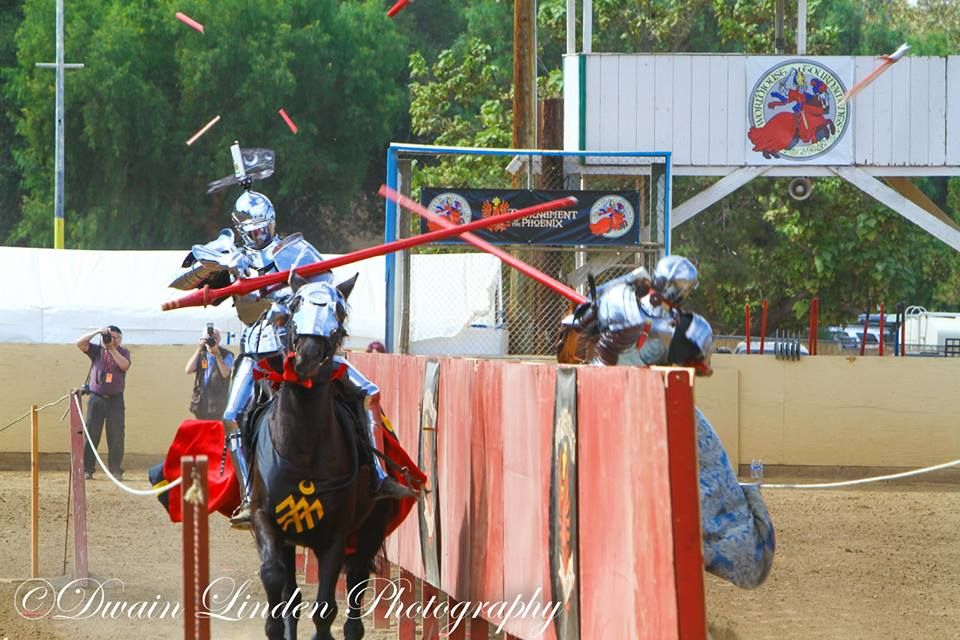
Toby Capwell(left) unhorses himself when he strikes Luc Petillot(right) who is rocked back,
but manages to stay on, Tournament of the Phoenix 2014 (photo by Dwain Linden Photography)
What other equestrian activities do you participate in?
Sadly, I’m not very active as a rider at the moment. I don’t have the time. I’m sure that will change, but not right now. I’ve played a bit of polo, but I’ve never been able to get excited about ball games. My good friend Mike Loades recently founded a mounted archery club in Petaluma, California (strangely, where I was born). I’d love to get into that.
Please tell us about the horse that you rode during the Tournament of the Phoenix.
In all my Phoenix appearances, I’ve been partnered up with Lucas, a little rocket-powered Azteca. He’s great, in every way. He won the tournament this year as much as me. In fact, he also won the mounted skill at arms competition with a different rider. He’s utterly wonderful to ride, and is actually one of those really rare horses who does both joust and tourney very well. Often the different nature of the two disciplines means that a horse is good at one or the other, but not both. Lucas does it all, with great spirit.
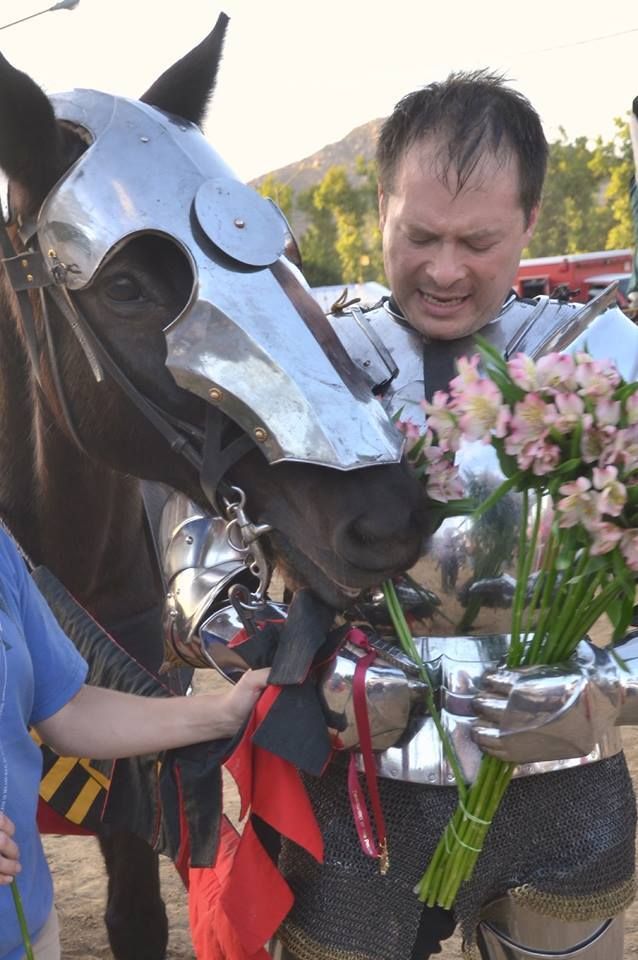
Azteca horse Lucas asserts that he deserves some of the prize flowers
that Toby Capwell is holding (photo by Michael Lozich)
When you were previously interviewed after the Grand Tournament of Sankt Wendel in 2012, you mentioned that the armour you were wearing for that tournament was based on pictorial sources from the Inventario Iluminado of Charles V. Are you still using that armour? If so please tell us more about it. If not, please describe your current jousting armour.
No, the Sankt Wendel armour was a special project. I wanted to get some kind of understanding of how those heavier jousting armours work and feel. It was an interesting project, and I’m glad I did it, but there isn’t much opportunity to use it. Only one other of my pals has one. At Sankt Wendel, he wore his and I wore mine, but the rest of the participants wore field armour with jousting helms. I don’t really like mixing armour styles. Historically, jousters tended to be very concerned about everyone having the same style of kit – the right armour for the right style of joust.
This year I have been jousting in my Italian field armour, which in style dates from c. 1465. It was made by Per Lillelund-Jensen and Jeff Wasson, with my armet by Robert Macpherson. I quite like having different parts by different craftsmen. That’s usually how it was done historically. The few homogeneous armours which survive, like the ‘Avant’ armour in the collections of Glasgow Museums, have the marks of different makers all over them. One master would oversee the making of a good armour, but the individual pieces were usually made by different specialists working under him, and they all had their own marks.
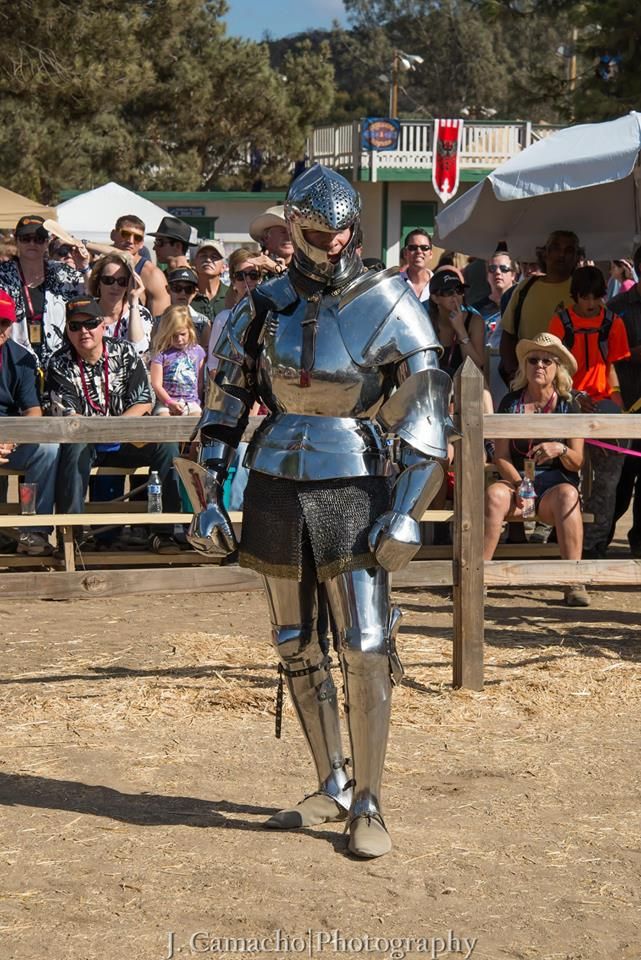

Left: Toby Capwell in his Italian field armour, c. 1465
Right: Toby Capwell's armet (photos by J Camacho Photography)
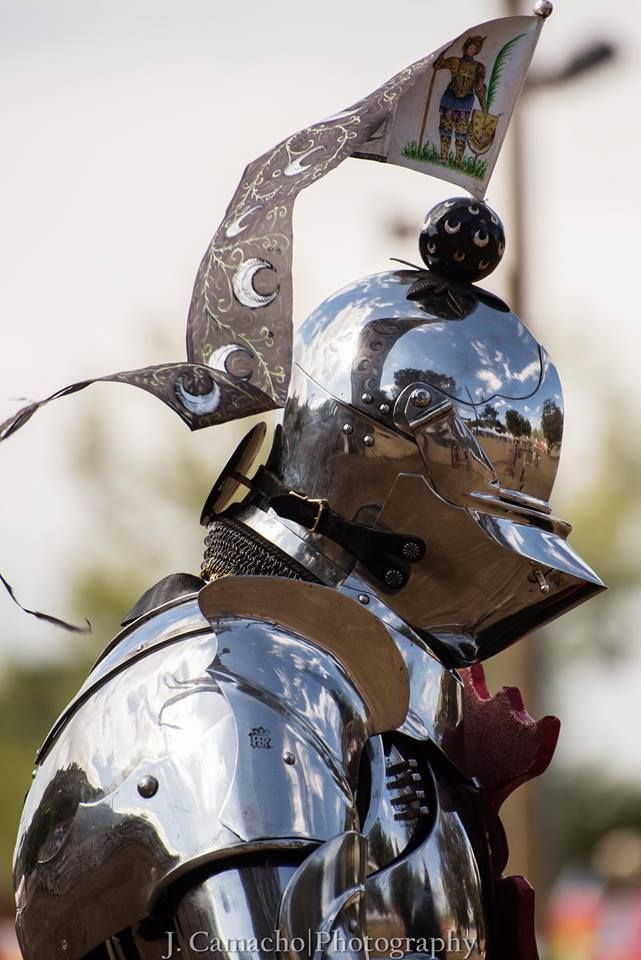
A side view of Toby Capwell's very shiny armet. Notice the reflections? You can also see
a maker's mark on his pauldron(shoulder armour) (photo by J. Camacho Photography)
What other styles of armour have you used for jousting in the past? What other styles would you like to try?
Well, my Italian armour has had a few different incarnations, then there was the English armour, and before that a few different German ones…. Basically it's all been mid-late fifteenth century field armour of one sort or another, with the exception of the Anglo-Flemish jousting armour mentioned above. I would have liked to have tried something late fourteenth or early fifteenth century, but I guess my really big last remaining armour dream project would be Elizabethan. I’d love to do a c. 1570s-80s English royal joust in a Greenwich garniture. But it’ll never happen. Too expensive. Because what would be the point of a Greenwich armour without all the etched and gilded decoration? And you need at least two to play…
Although your armour has changed several times, the design of your heraldic coat-of-arms has remained the same. How did you come up with that design?
Armour can change, but arms should never change. They are your visual name. I chose mine when I first needed them, when I started jousting at the Royal Armouries in the mid-90s. Heraldry is a complex subject, and often misunderstood. It is a visual language. Like a written language, it has rules. These rules need to be followed for it to work and to look right.
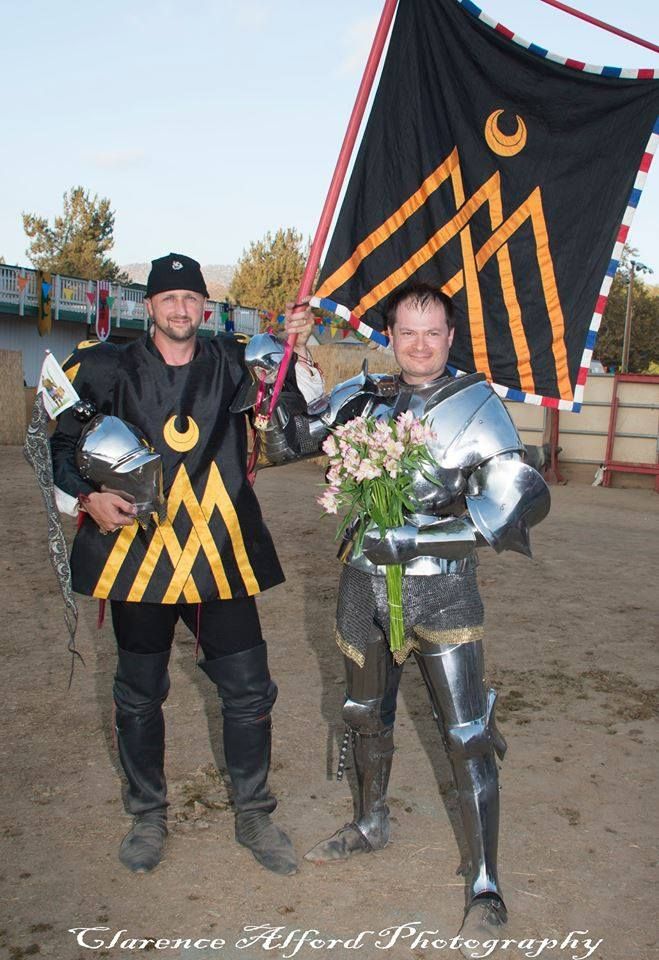
Toby Capwell and his squire, Lonnie Colson, who is wearing a surcoat and holding a banner
displaying Toby's heraldic arms (photo by Clarence Alford Photography)
I wish heraldry was better understood and appreciated in the jousting community. It really is as simple as knowing how to say your own name in visual terms. It isn’t really a license to just make up whatever you want. If a coat-of-arms looks obviously modern, if it doesn’t have an authentic feel, it kind of blows the whole show for everyone.
Coats-of-arms also have specific uses. Personal coats of arms were rarely worn in jousts for example. In a joust, everyone already knows who you are, and in one-on-one contests, identification isn’t that complicated. Personal identification is obviously much more important in the tourney, and on the battlefield.
It’s also really important to understand the distinction between heraldic and non-heraldic display. Richard III never wore the white boar badge personally. The white boar, just as an example, is not a heraldic device – it is a livery badge. It was a way of expressing loyalty to someone else, not personal identity. Richard’s personal coat-of-arms as King was the royal arms – the lilies and leopards of the King of England.
Despite all of that, I had intended to wear all my own personal heraldry at the Phoenix this year. But I couldn’t get my personal shield into my luggage and keep within the weight limits. So I started the event with my team shield (red with silver crescents; non-heraldic, expressing team loyalty).
Then that was destroyed by Dmitry [Savchenko] on the first day. Jeff [Hedgecock] then kindly lent me one of his, which was emblazoned with the gold escarbuncle, a badge used by the original historical Order of the Crescent, and also by our modern jousting team of the same name, which takes its themes and inspiration from the historical order. The escarbuncle is in this context a non-heraldic image closely associated with St Maurice, patron saint of the historical order. So I ended up, correctly, using a non-heraldic shield in the joust, despite my contrary intentions.
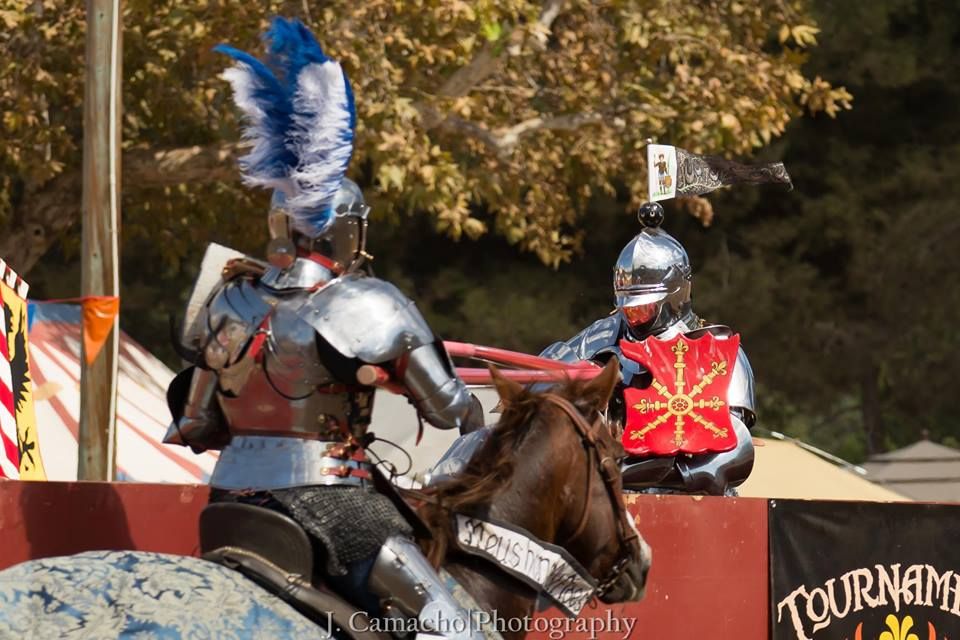
Luc Petillot(left) jousts Toby Capwell(right) who is wearing the gold escarbuncle shield
(photo by J. Camacho Photography)
What are your degrees in, and how does your academic experience influence your jousting? Or vice versa?
I have a BA (history and English literature); two MAs (Art Gallery and Museum Studies; Medieval Studies) and a PhD (Medieval Studies). Certainly my academic experience has equipped me to do better historical research than I would have known how to do otherwise, and this has meant I’ve been in a better position to research armour, saddles, horses, lance technique, heraldry… all the stuff that is essential to good jousting. I’ve also tried to help provide research material and ideas to other jousters who don’t have the advantage of a full-time job researching this sort of thing.
Toby Capwell talks about how his experiences with the Royal Armouries
inspired his academic career (video from Creative Spaces)
Please tell us about your work as Curator of Arms and Armour at the Wallace Collection and how it relates to your jousting.
At the Wallace Collection I am responsible for arms and armour- European, Islamic, Indian, and South Asian. It is around 44% of the total museum holdings. I write books about the collection, do talks and lectures, publish articles, answer inquiries, manage volunteers and interns, and am project leader on the museum’s Islamic, Indian and South Asian arms and armour cataloging project. Plenty to do! We have some nice jousting pieces in the collection, including a Stechzeug from the Nuremberg Gesellenstechen series and three Anton Peffenhauser jousting armours dating from the late sixteenth century.
What would you like to say about/to the others involved in the Tournament of the Phoenix 2014?
Just that it was one of the best organised events I’ve ever had the pleasure of attending. Everyone was on the same page. Everyone had a shared vision for what it should be. Everyone wore clothing and equipment of the same period and quality, everyone was united, paying attention, and having a great time. Also, vitally, everyone was really well taken care of. Good accommodation, good food, good beer. Lots of concern for safety and well-being. Physiotherapy! This often gets forgotten about, which is crazy, given what we are trying to do.
I just really enjoyed it. Often I’ve been so into the intricacies of research and preparation that I’ve forgotten to enjoy myself, or have not been able to for whatever reason. But this one was really special. And it would have been, even if I had ended up at the bottom of the scoreboard instead of at the top. Everybody got it. It clicked. That’s really hard to achieve.
Ultimately real historical tournaments were supposed to be great social occasions, of celebration and spectacle. This time it happened like that.
What are your plans/hopes for the future?
Well, to be a dad/husband, a curator, and an author. In that order. Beyond my work at the museum, the first book in what I hope will be a three-volume trilogy (watch out Peter Jackson, I’m catching up!) publishing, finally, my research on armour in England, will be coming out next year, but there is a shed-load of work over the next three months that needs to be done to make it happen. I’m on it. I think.
Thank you for taking the time to answer these questions, and best of luck in the future.
A pleasure, and thank you!
You can see more videos featuring Toby on the Dr. Tobias Capwell playlist on The Jousting Life YouTube Chanel, and here are a few more photos from the Tournament of the Phoenix and of Toby:
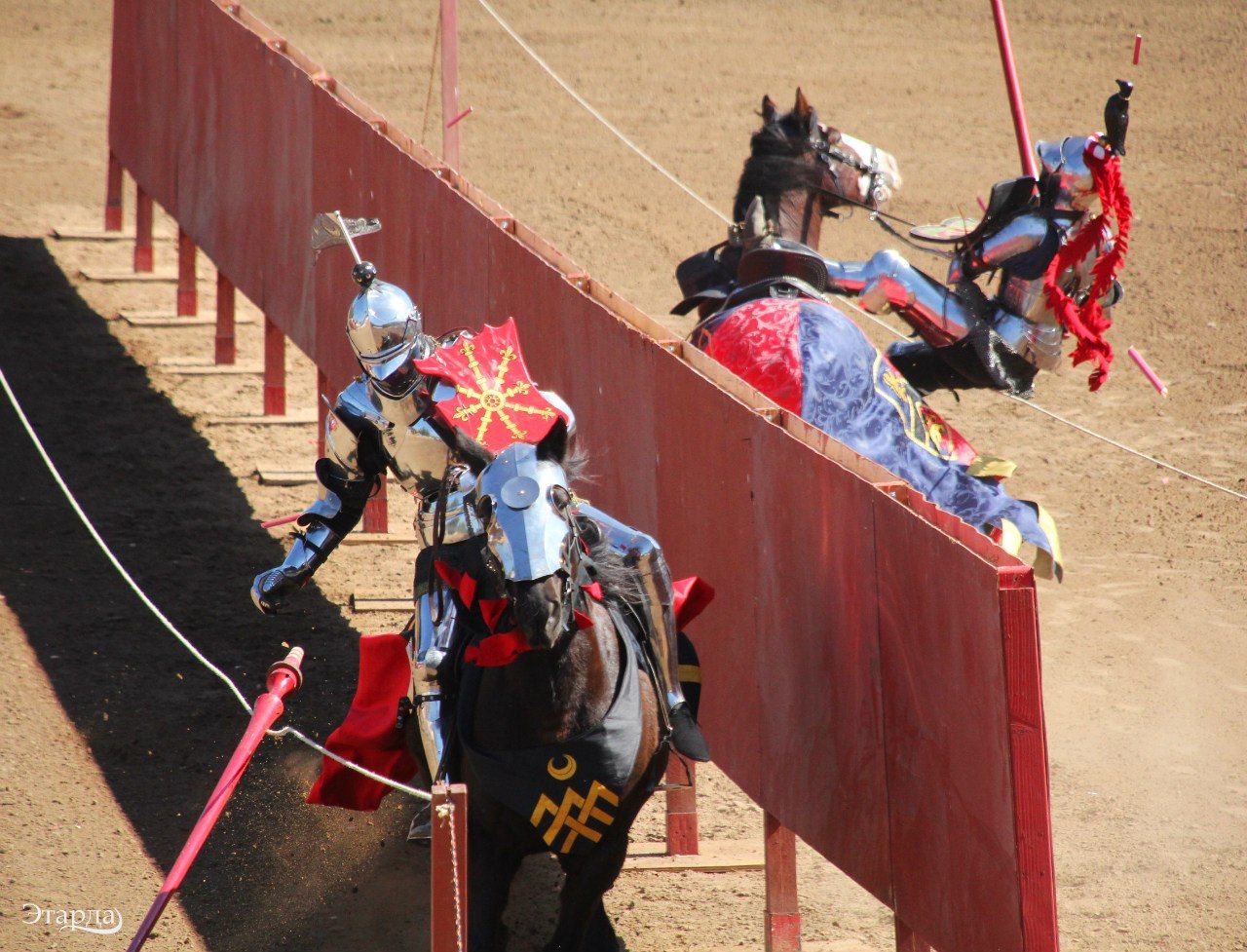
Toby Capwell unhorses Darth Rimmer, Phoenix 2014(photo by Marina Savchenko)
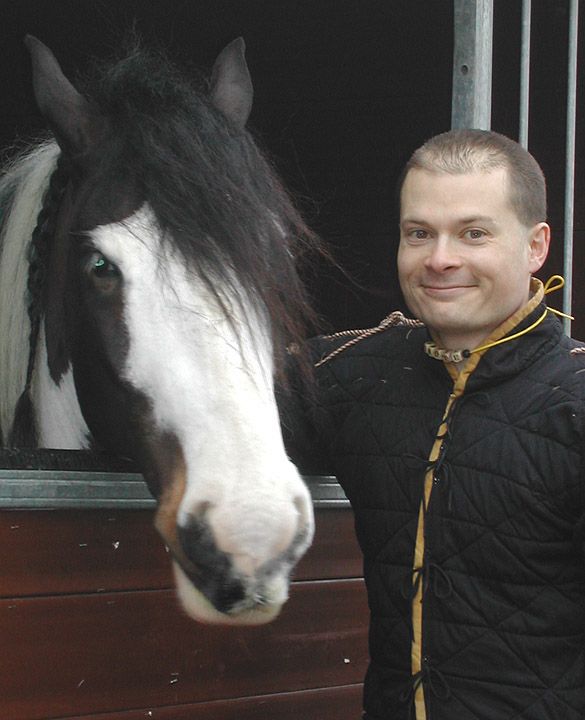
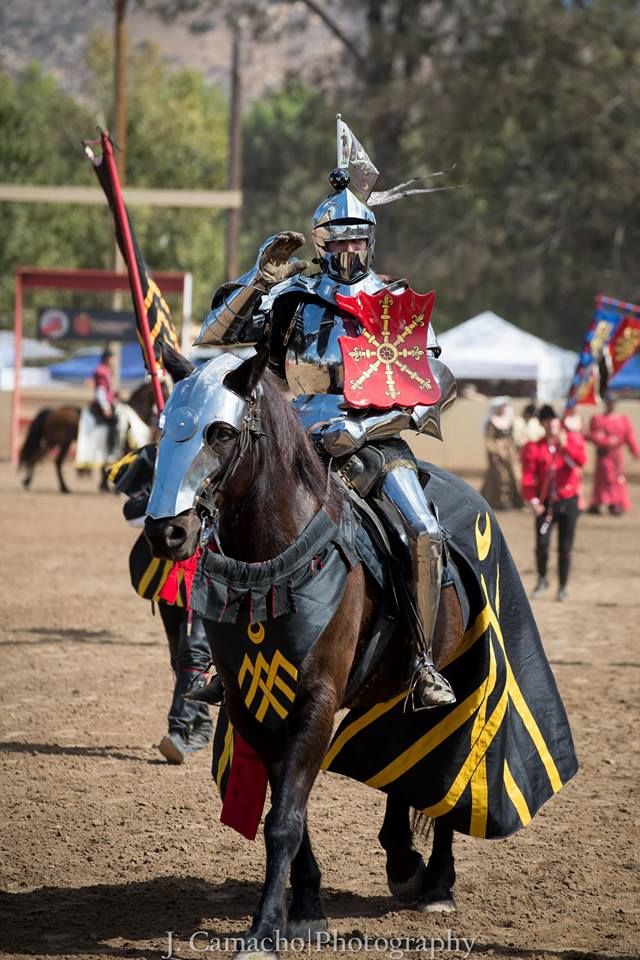
Left: Toby Capwell and the horse Switch, Royal Armouries Leeds 2005 (photo from Order of the Crescent) Right: Toby Capwell waves to the crowd, Tournament of the Phoenix 2014 (photo by J. Camacho Photography)
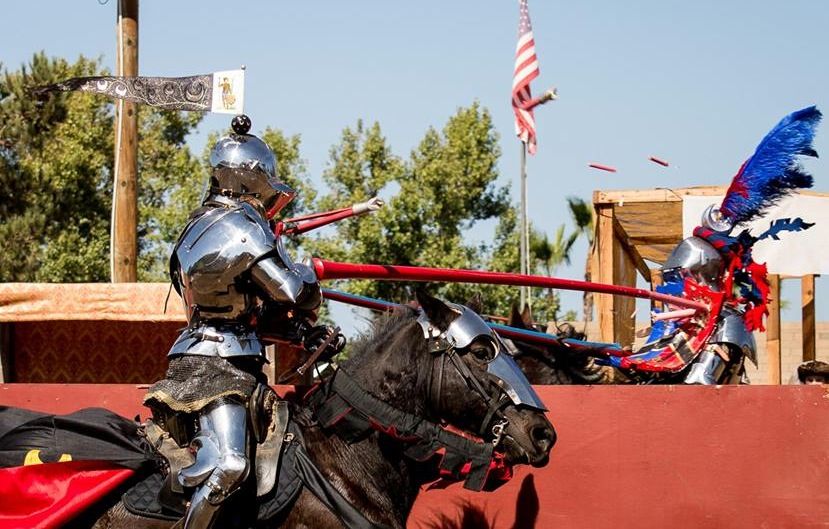
Toby Capwell(left) and Jeffrey Hedgecock(right) both break lances against one another,
Phoenix 2014 (photo by J. Camacho Photography)
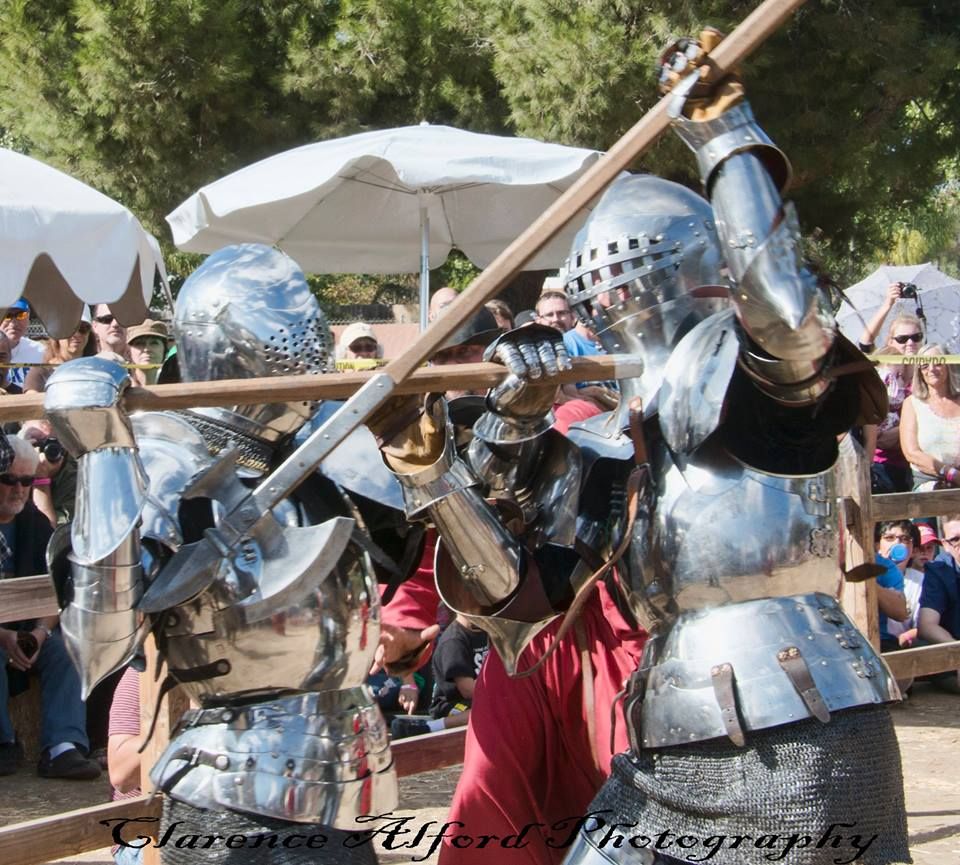
Toby Capwell(left) fights Alix van Zilj(right) in the poleaxe competition,
Phoenix 2014 (photo by Clarence Alford Photography)
Related articles:
An Interview with Dr. Tobias Capwell: Jouster at The Grand Tournament in Sankt Wendel
Toby Capwell is Writing Blog Posts about the Grand Tournament at Schaffhausen!
Guest Writer, Jouster Marc Hamel: Acts of Valor
Esprit de Corps Dominates at the Tournament of the Phoenix 2012
Guest Writer, Photographer Oliver Dunsch: My Day in Sankt Wendel

Toby Capwell, Tournament Champion, on the Azteca horse, Lucas, who carried Toby throughout the tournament, Tournament of the Phoenix 2014 (photo by Clarence Alford Photography)
This year's tournament was held the weekend of October 17 - 19, in Poway, California, USA, and involved not only a jousting competition, but also mounted melee and poleaxe competitions, as well as an award for the most chivalrous. There were a total of six jousters from five different countries who competed:
Alix van Zijl of the Netherlands
Darth Rimmer of the USA
Dmitry Savchenko of Russia (received the Chivalry Prize)
Jeffrey Hedgecock of the USA
Luc Petillot of France
Toby Capwell of the UK

Left to right: Alix van Zijl, Luc Petillot, Darth Rimmer, Toby Capwell, Dmitry Savchenko
and Jeffrey Hedgecock (photo from Tournament of the Phoenix)
There was also a separate competition in mounted skill at arms which was won by Chris Godby.

Chris Godby, riding the Azteca horse Lucas, winner of the MSA competition,
Tournament of the Phoenix 2014 (photo by J. Camacho Photography)
This year's tournament champion, Toby Capwell, is not your average jouster. He is Curator of Arms and Armour at the Wallace Collection in London and is an internationally-acknowledged expert on medieval and Renaissance weapons. He has written widely on this fascinating subject. His books include: The Real Fighting Stuff: Arms and Armour at Glasgow Museums (Glasgow: Glasgow Museums, 2006); Masterpieces of European Arms and Armour in the Wallace Collection (London: Paul Holberton, 2011), winner of Apollo Magazine’s Book of the Year (2012); and The Noble Art of the Sword: Fashion and Fencing in Renaissance Europe 1520-1630 (London: Paul Holberton, 2012). The first book covering his fifteen years of research on armour in England during the fifteenth century will be published in 2015.
Toby also appears regularly on television, most recently as presenter and armour advisor on Richard III: The New Evidence (Channel 4; 2014), released in the USA as Secrets of the Dead: Resurrecting Richard III. He was also the writer and presenter of Metalworks: The Knight’s Tale (BBC4; 2012).
The world’s only jousting curator, Toby has been competing in tournaments all over the world for twenty years. Building and fighting in armour have fundamentally informed his scholarly approach to an intensely physical subject, allowing him to experience it in ways that would be impossible otherwise.
Toby approaches his subject in a passionate and unique way, offering personal and original insights into weapons, armour, horses, chivalric combat, and their deeper significance for the people who lived in the Middle Ages.
Toby Capwell explains his passion for jousting in a video created for the
Grand Tournament of Schaffhausen (video by Ritterturnier Schaffhausen)
Toby graciously agreed to answer some questions about winning the Tournament of the Phoenix and his other jousting experiences.
Congratulations on winning the Tournament of the Phoenix 2014!
Thanks!
How did you become involved with the Tournament of the Phoenix, and how long have you been competing in it?
I’ve known the event producers for a long time – Jeff and Gwen first started coming to the tournaments at the Royal Armouries in Leeds about ten years ago. Jeff and I formed a team with two other friends a bit later on. It all kind of went from there. I first fought at the Phoenix in 2008, and then have gone every other year since, again in 2010, 2012, and 2014.
Please describe one of your favorite moments during the tournament.
It’s funny, this time around it was small, perhaps slightly inconsequential things that made an impression on me. There was a moment during a pass run by Luc Petillot against someone else – can’t remember who – when Luc’s lance was knocked out of his hand by the force of his strike. The lance somehow bounced across his body and started to fall down between his horse’s near side and the tilt. Automatically, without looking or seeing, Luc reached down with his right hand across his body, still at a fast gallop, and retrieved it.
I was right at the end of the tilt and saw the whole thing perfectly. I was really impressed, because it showed not only skill, but also concern for the safety of the people around him. The historical jousting treatises say that the lance (or whatever is left of it) should never be thrown down after an encounter. The jouster should always hold on to it until it can be safely taken from him. Luc just showed in that moment that he was a real jouster with good awareness and the right attitude.

Luc Petillot(left) shakes hands with Toby Capwell(right), Tournament of the Phoenix 2014
(photo by J. Camacho Photography)
What is your favorite memory from any of your previous jousting experiences?
No question about it, when my 3-year-old son showed up unexpectedly in Switzerland this year, to see me joust in Schaffhausen. Seeing him peering over the grandstand railing was incredibly moving. He looked at me across the field, and I looked at him, I raised my hand, and he lit up and waved back. Magical.
Of course his favourite jouster now is Alix [van Zijl], not me. Understandable, I suppose.
How did you become involved with jousting?
Matthew Mansour gave me a job jousting for him back in 1993… I jousted in the USA for a couple years, then ended up in the UK, jousting at the Royal Armouries from 1996 onwards.

Toby Capwell(left) is featured with Matthew Mansour(right) on the cover of the
May 1995 Renaissance Herald (photo provided by The Jousters)
What aspect of learning to joust did you find most difficult?
Riding. It’s all about the riding. The rest is easy.
What accomplishment within the field of jousting are you most proud of?
Staying on. Most of the time.

Toby Capwell(left) unhorses himself when he strikes Luc Petillot(right) who is rocked back,
but manages to stay on, Tournament of the Phoenix 2014 (photo by Dwain Linden Photography)
What other equestrian activities do you participate in?
Sadly, I’m not very active as a rider at the moment. I don’t have the time. I’m sure that will change, but not right now. I’ve played a bit of polo, but I’ve never been able to get excited about ball games. My good friend Mike Loades recently founded a mounted archery club in Petaluma, California (strangely, where I was born). I’d love to get into that.
Please tell us about the horse that you rode during the Tournament of the Phoenix.
In all my Phoenix appearances, I’ve been partnered up with Lucas, a little rocket-powered Azteca. He’s great, in every way. He won the tournament this year as much as me. In fact, he also won the mounted skill at arms competition with a different rider. He’s utterly wonderful to ride, and is actually one of those really rare horses who does both joust and tourney very well. Often the different nature of the two disciplines means that a horse is good at one or the other, but not both. Lucas does it all, with great spirit.

Azteca horse Lucas asserts that he deserves some of the prize flowers
that Toby Capwell is holding (photo by Michael Lozich)
When you were previously interviewed after the Grand Tournament of Sankt Wendel in 2012, you mentioned that the armour you were wearing for that tournament was based on pictorial sources from the Inventario Iluminado of Charles V. Are you still using that armour? If so please tell us more about it. If not, please describe your current jousting armour.
No, the Sankt Wendel armour was a special project. I wanted to get some kind of understanding of how those heavier jousting armours work and feel. It was an interesting project, and I’m glad I did it, but there isn’t much opportunity to use it. Only one other of my pals has one. At Sankt Wendel, he wore his and I wore mine, but the rest of the participants wore field armour with jousting helms. I don’t really like mixing armour styles. Historically, jousters tended to be very concerned about everyone having the same style of kit – the right armour for the right style of joust.
This year I have been jousting in my Italian field armour, which in style dates from c. 1465. It was made by Per Lillelund-Jensen and Jeff Wasson, with my armet by Robert Macpherson. I quite like having different parts by different craftsmen. That’s usually how it was done historically. The few homogeneous armours which survive, like the ‘Avant’ armour in the collections of Glasgow Museums, have the marks of different makers all over them. One master would oversee the making of a good armour, but the individual pieces were usually made by different specialists working under him, and they all had their own marks.


Left: Toby Capwell in his Italian field armour, c. 1465
Right: Toby Capwell's armet (photos by J Camacho Photography)

A side view of Toby Capwell's very shiny armet. Notice the reflections? You can also see
a maker's mark on his pauldron(shoulder armour) (photo by J. Camacho Photography)
What other styles of armour have you used for jousting in the past? What other styles would you like to try?
Well, my Italian armour has had a few different incarnations, then there was the English armour, and before that a few different German ones…. Basically it's all been mid-late fifteenth century field armour of one sort or another, with the exception of the Anglo-Flemish jousting armour mentioned above. I would have liked to have tried something late fourteenth or early fifteenth century, but I guess my really big last remaining armour dream project would be Elizabethan. I’d love to do a c. 1570s-80s English royal joust in a Greenwich garniture. But it’ll never happen. Too expensive. Because what would be the point of a Greenwich armour without all the etched and gilded decoration? And you need at least two to play…
Although your armour has changed several times, the design of your heraldic coat-of-arms has remained the same. How did you come up with that design?
Armour can change, but arms should never change. They are your visual name. I chose mine when I first needed them, when I started jousting at the Royal Armouries in the mid-90s. Heraldry is a complex subject, and often misunderstood. It is a visual language. Like a written language, it has rules. These rules need to be followed for it to work and to look right.
Heraldry is a complex subject, and often misunderstood. It is a visual language. Like a written language, it has rules. These rules need to be followed for it to work and to look right.I not only wanted my arms to work, I wanted them to look medieval. Medieval heraldry looks different than 17th-century heraldry, which is different than modern heraldry. So I basically just looked through a lot of real fifteenth century armorials – basically lists of hundreds of medieval knights with each coat-of-arms illustrated – until I saw an overall design which seemed to jump off the page. Then I just changed the colours, so I wasn’t claiming to be that person. The original is argent, three chevronels interlaced and a crescent sable, and mine is sable, three chevronels interlaced and a crescent or. The original belonged to Sir Robert Brackenbury, Constable of the Tower under King Richard III.

Toby Capwell and his squire, Lonnie Colson, who is wearing a surcoat and holding a banner
displaying Toby's heraldic arms (photo by Clarence Alford Photography)
I wish heraldry was better understood and appreciated in the jousting community. It really is as simple as knowing how to say your own name in visual terms. It isn’t really a license to just make up whatever you want. If a coat-of-arms looks obviously modern, if it doesn’t have an authentic feel, it kind of blows the whole show for everyone.
Coats-of-arms also have specific uses. Personal coats of arms were rarely worn in jousts for example. In a joust, everyone already knows who you are, and in one-on-one contests, identification isn’t that complicated. Personal identification is obviously much more important in the tourney, and on the battlefield.
It’s also really important to understand the distinction between heraldic and non-heraldic display. Richard III never wore the white boar badge personally. The white boar, just as an example, is not a heraldic device – it is a livery badge. It was a way of expressing loyalty to someone else, not personal identity. Richard’s personal coat-of-arms as King was the royal arms – the lilies and leopards of the King of England.
Despite all of that, I had intended to wear all my own personal heraldry at the Phoenix this year. But I couldn’t get my personal shield into my luggage and keep within the weight limits. So I started the event with my team shield (red with silver crescents; non-heraldic, expressing team loyalty).
Then that was destroyed by Dmitry [Savchenko] on the first day. Jeff [Hedgecock] then kindly lent me one of his, which was emblazoned with the gold escarbuncle, a badge used by the original historical Order of the Crescent, and also by our modern jousting team of the same name, which takes its themes and inspiration from the historical order. The escarbuncle is in this context a non-heraldic image closely associated with St Maurice, patron saint of the historical order. So I ended up, correctly, using a non-heraldic shield in the joust, despite my contrary intentions.

Luc Petillot(left) jousts Toby Capwell(right) who is wearing the gold escarbuncle shield
(photo by J. Camacho Photography)
What are your degrees in, and how does your academic experience influence your jousting? Or vice versa?
I have a BA (history and English literature); two MAs (Art Gallery and Museum Studies; Medieval Studies) and a PhD (Medieval Studies). Certainly my academic experience has equipped me to do better historical research than I would have known how to do otherwise, and this has meant I’ve been in a better position to research armour, saddles, horses, lance technique, heraldry… all the stuff that is essential to good jousting. I’ve also tried to help provide research material and ideas to other jousters who don’t have the advantage of a full-time job researching this sort of thing.
Toby Capwell talks about how his experiences with the Royal Armouries
inspired his academic career (video from Creative Spaces)
Please tell us about your work as Curator of Arms and Armour at the Wallace Collection and how it relates to your jousting.
At the Wallace Collection I am responsible for arms and armour- European, Islamic, Indian, and South Asian. It is around 44% of the total museum holdings. I write books about the collection, do talks and lectures, publish articles, answer inquiries, manage volunteers and interns, and am project leader on the museum’s Islamic, Indian and South Asian arms and armour cataloging project. Plenty to do! We have some nice jousting pieces in the collection, including a Stechzeug from the Nuremberg Gesellenstechen series and three Anton Peffenhauser jousting armours dating from the late sixteenth century.
What would you like to say about/to the others involved in the Tournament of the Phoenix 2014?
Just that it was one of the best organised events I’ve ever had the pleasure of attending. Everyone was on the same page. Everyone had a shared vision for what it should be. Everyone wore clothing and equipment of the same period and quality, everyone was united, paying attention, and having a great time. Also, vitally, everyone was really well taken care of. Good accommodation, good food, good beer. Lots of concern for safety and well-being. Physiotherapy! This often gets forgotten about, which is crazy, given what we are trying to do.
I just really enjoyed it. Often I’ve been so into the intricacies of research and preparation that I’ve forgotten to enjoy myself, or have not been able to for whatever reason. But this one was really special. And it would have been, even if I had ended up at the bottom of the scoreboard instead of at the top. Everybody got it. It clicked. That’s really hard to achieve.
Ultimately real historical tournaments were supposed to be great social occasions, of celebration and spectacle. This time it happened like that.
What are your plans/hopes for the future?
Well, to be a dad/husband, a curator, and an author. In that order. Beyond my work at the museum, the first book in what I hope will be a three-volume trilogy (watch out Peter Jackson, I’m catching up!) publishing, finally, my research on armour in England, will be coming out next year, but there is a shed-load of work over the next three months that needs to be done to make it happen. I’m on it. I think.
Thank you for taking the time to answer these questions, and best of luck in the future.
A pleasure, and thank you!
You can see more videos featuring Toby on the Dr. Tobias Capwell playlist on The Jousting Life YouTube Chanel, and here are a few more photos from the Tournament of the Phoenix and of Toby:

Toby Capwell unhorses Darth Rimmer, Phoenix 2014(photo by Marina Savchenko)


Left: Toby Capwell and the horse Switch, Royal Armouries Leeds 2005 (photo from Order of the Crescent) Right: Toby Capwell waves to the crowd, Tournament of the Phoenix 2014 (photo by J. Camacho Photography)

Toby Capwell(left) and Jeffrey Hedgecock(right) both break lances against one another,
Phoenix 2014 (photo by J. Camacho Photography)
Top left: Toby Capwell(far right) during a mounted melee, Phoenix 2014
Bottom right: Toby Capwell(left) and Dmitry Savchenko(right) exchange glances during a mounted melee, Phoenix 2014 (photos by Marina Savchenko)
Bottom right: Toby Capwell(left) and Dmitry Savchenko(right) exchange glances during a mounted melee, Phoenix 2014 (photos by Marina Savchenko)

Toby Capwell(left) fights Alix van Zilj(right) in the poleaxe competition,
Phoenix 2014 (photo by Clarence Alford Photography)
Top left: Steve Mallet, Toby Capwell and Jeffrey Hedgecock, 2005 (photo from Order of the Crescent) Bottom right: Bill Burch, Matthew Mansour, Toby Capwell, 1993(photo from The Jousters)
Related articles:
An Interview with Dr. Tobias Capwell: Jouster at The Grand Tournament in Sankt Wendel
Toby Capwell is Writing Blog Posts about the Grand Tournament at Schaffhausen!
Guest Writer, Jouster Marc Hamel: Acts of Valor
Esprit de Corps Dominates at the Tournament of the Phoenix 2012
Guest Writer, Photographer Oliver Dunsch: My Day in Sankt Wendel

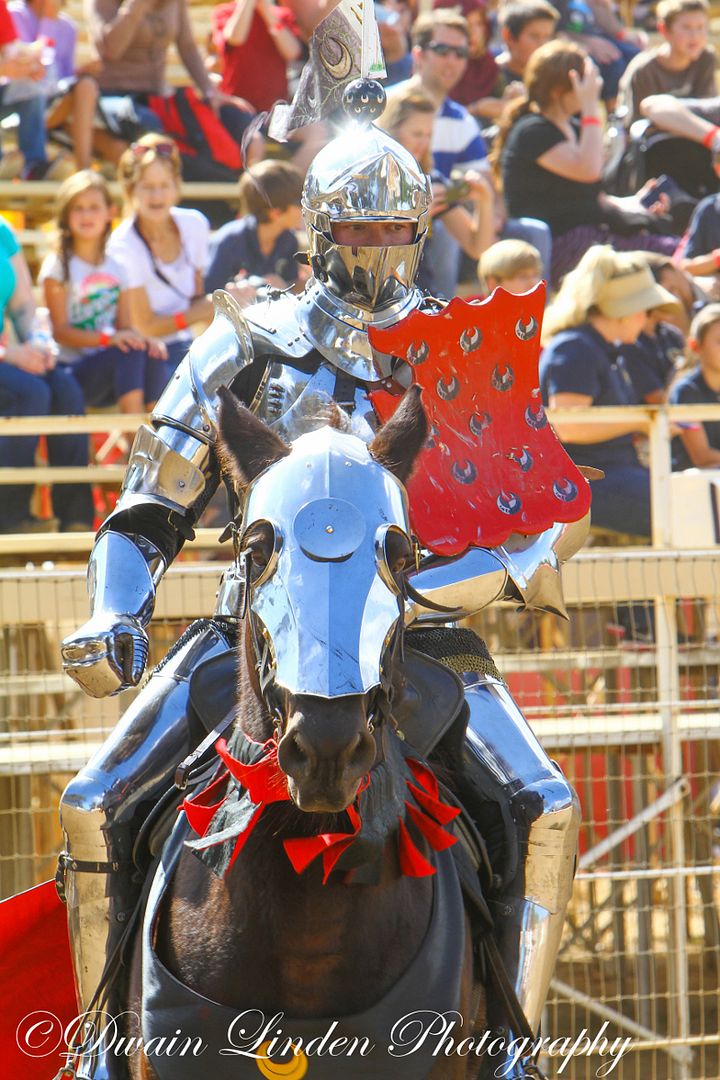
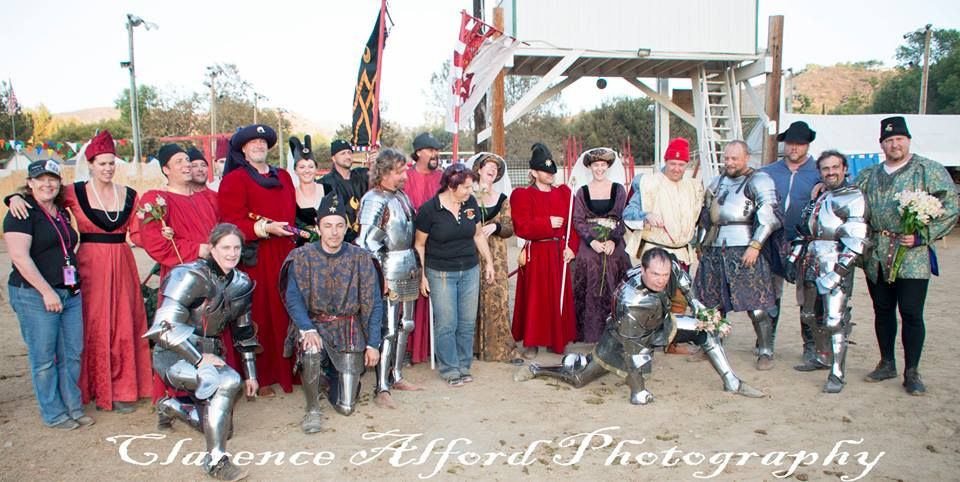
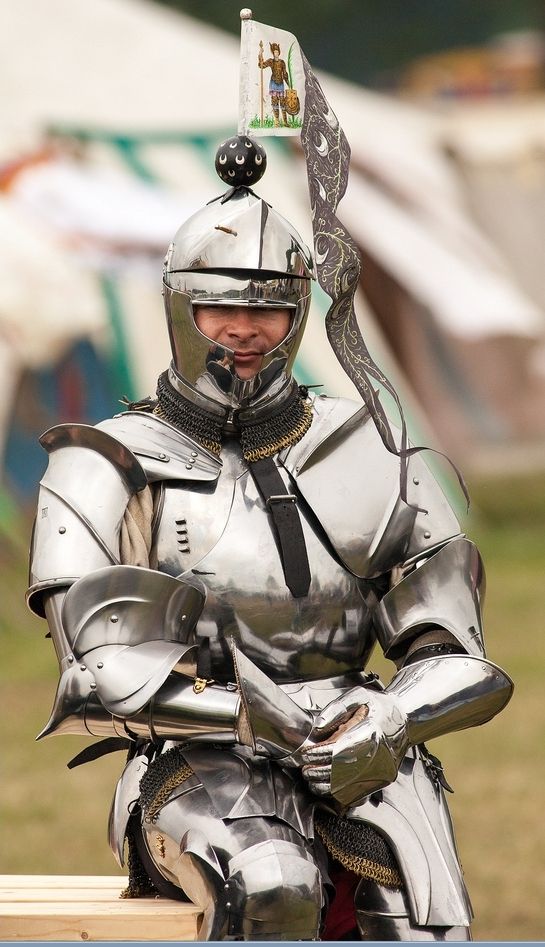
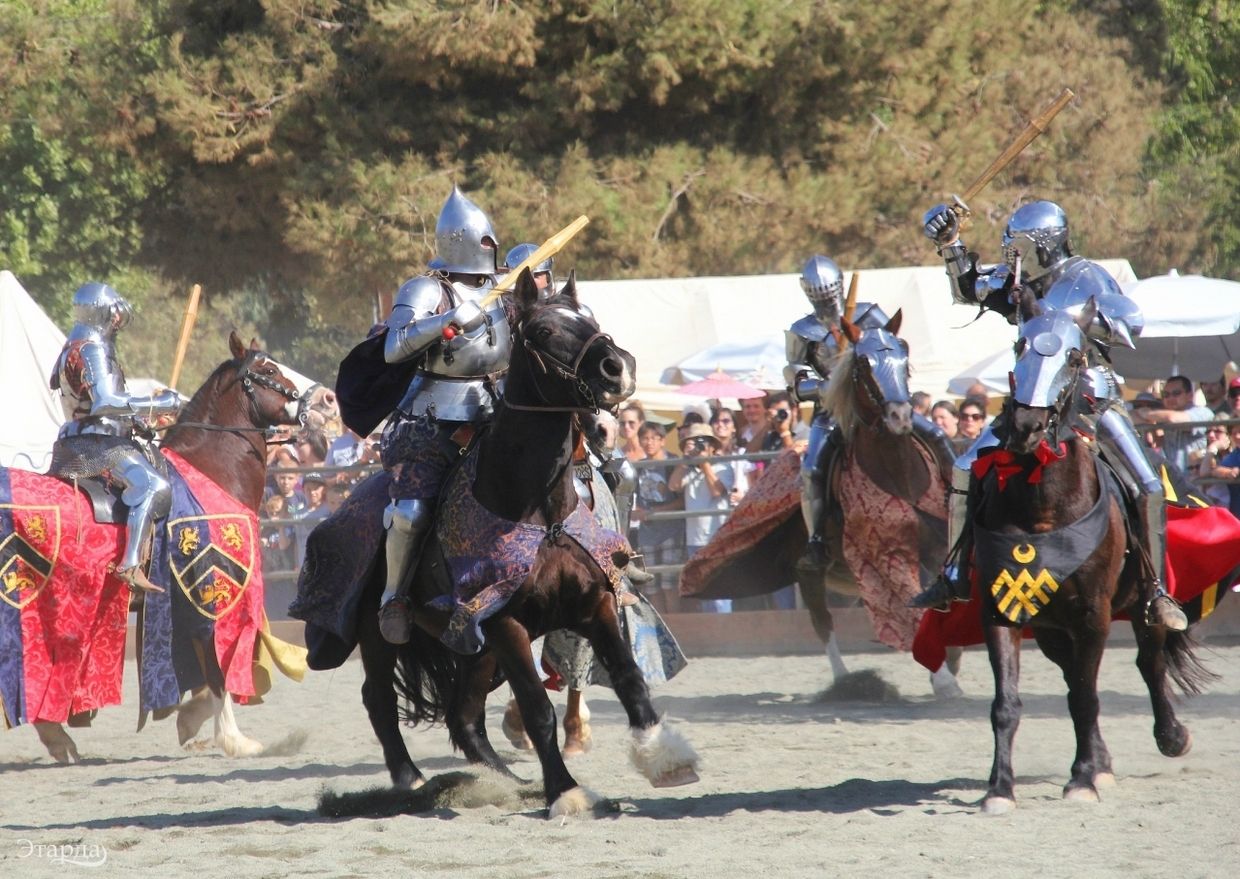
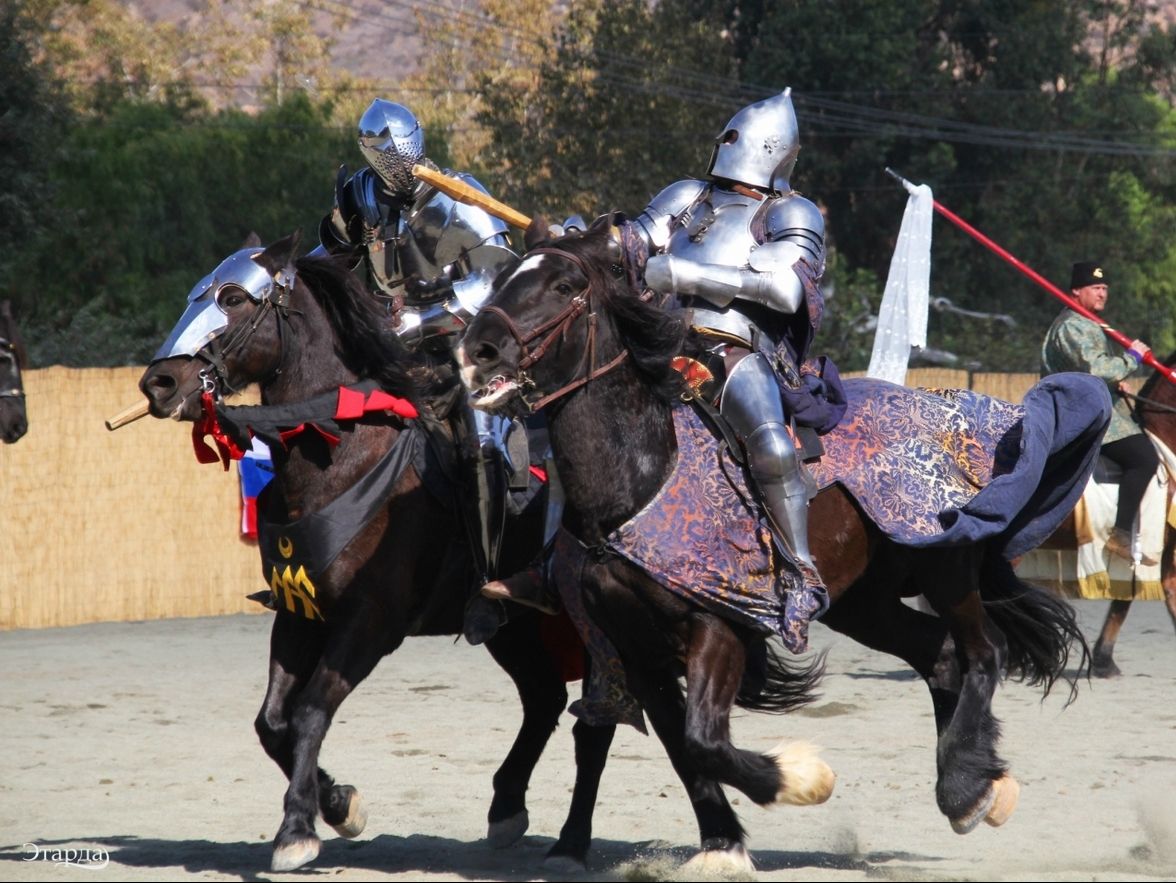
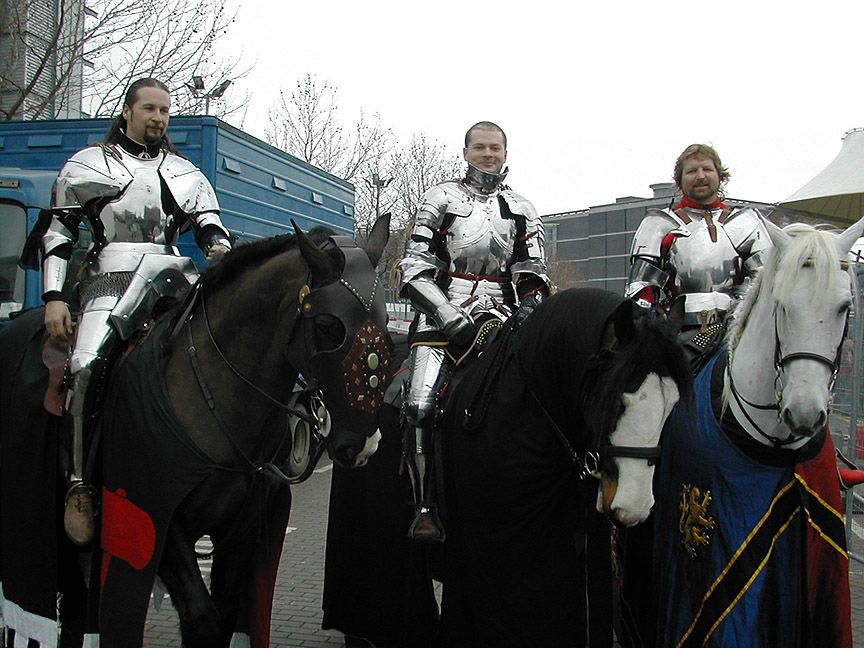
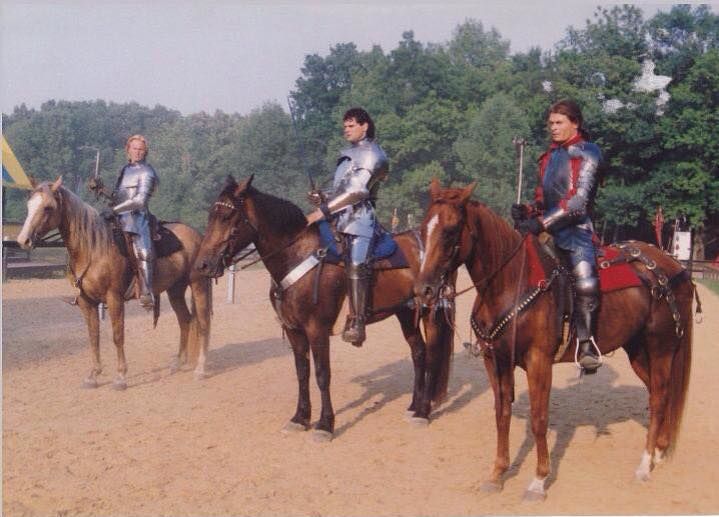

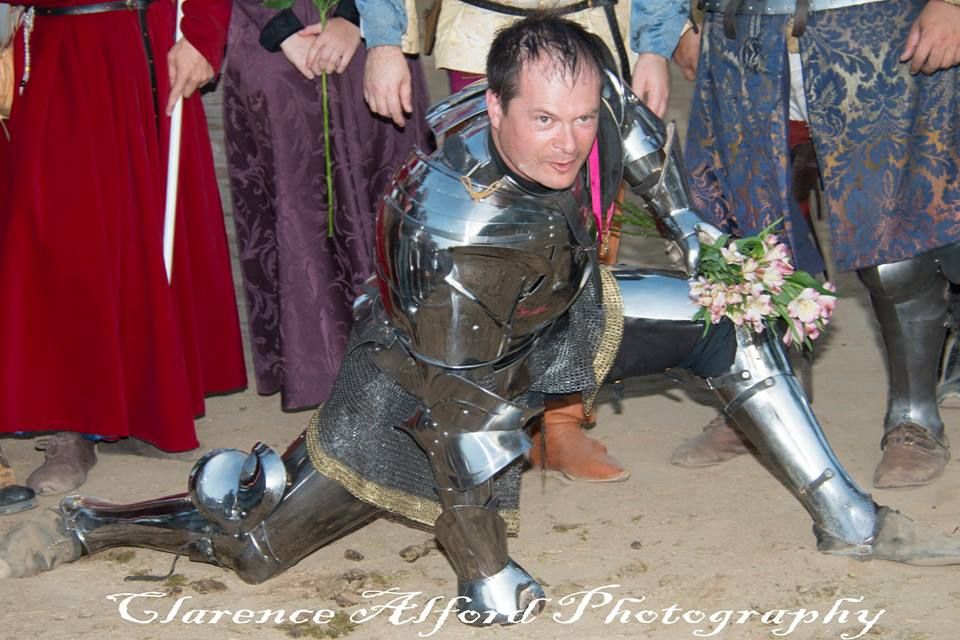
No comments:
Post a Comment